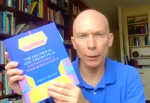“The establishment of thermodynamics during the middle years of the nineteenth century – one of the great creative epochs of science – was so rapid and extensive that a whole new branch of knowledge was suddenly created, where previously there had been the old science of heat plus the substantially empirical technology of heat-engines.” – D. S. L. Cardwell [1]
Rudolf Clausius arguably fathered thermodynamics with his seminal 1850 paper in which he established the 1st Law of Thermodynamics by merging the ideas Sadi Carnot and James Joule (click here). Unfortunately, understanding this paper was no easy feat. Writing about a new paradigm with new words, concepts, and theories is difficult enough as it is. But when the break from the old to the new isn’t clean, the difficulty for the writer and thus for the reader rises to a higher level.
The challenge of creating & authoring a new paradigm
As a stickler for exact definitions and terminology, Clausius was quite rigorous with his writing, which helped for the sake of brevity and intentionality. The words he chose and later created meant very specific concepts. Unfortunately, as it would also be for Gibbs, his writing approach for such a complicated subject didn’t always result in clarity for the reader. If you didn’t understand it the first time around, there was no second time. Clausius didn’t spend much additional time clarifying certain of his statements, perhaps because such statements were already clear to him, thus leaving the reader to have to work rather hard to understand or guess at his logic, but also perhaps because he himself struggled to conceptually unite Carnot and Joule. One can only imagine how often Clausius may have deeply questioned the deeply abstract concept of energy. In such a mindset, the challenge of untangling the concepts and terminologies associated with the dying caloric from those that would soon be associated with energy was quite large. In fact, this task was never completed. Consider that we continue to talk about a “flow” of heat and the different varieties of heat: latent, sensible, liberated and free. All of these and more, like heat capacity and heat balance, as opposed to energy balance, are relics of the caloric theory. These terms confuse us, largely when we attempt to interpret their literal meaning in today’s world of energy. Clausius certainly faced similar issues. The point here is simply to convey that the job of creating a new paradigm with strictly defined words was an immense undertaking.
Clausius and heat – the core issue
The challenge in reading his 1850 paper is that Clausius never flatly rejected caloric. In fact, he never even used the word, but instead relied on the word “heat.” For Clausius, it wasn’t necessarily about whether or not heat (as a noun) existed, but instead about the rejection of its conservation, although I’m really not sure as historians don’t know much about Clausius’ thinking apart from his papers; no extensive secondary literature on Clausius the person exists. [2] At times, I read in his words that while he may have rejected the conservation of heat, he may still have retained certain concepts originating from the caloric theory. In referring to Clausius’ view (post-1850) that the work accomplished in an engine cycle is caused by the fall of heat, Daub wrote, “Undoubtedly, Clausius was still under the influence of the caloric theory.” [3]
Clausius took the first major step towards thermodynamics
With his 1850 publication, Clausius arguably launched classical thermodynamics. Yes, others such as Carnot, Joule, and William Thomson (Lord Kelvin) helped lay the groundwork, but it was Clausius who took the first major step, it was Clausius alone who solved the problem of Carnot and Joule, it was Clausius who arrived at the first mathematical statement of the 1st Law of Thermodynamics.
The new paradigm of energy arrives
The science in the mid-1800s was in such a significant state of flux, caused by the arrival of the concept of energy and its collision with Carnot, that it must have felt for many like being on a small boat in a rough sea. Thankfully, Clausius stepped in, placed a steady hand on the tiller, and helped guide the boat out. Yes, his writing was a challenge to read. But the quality and reliability of his work were undeniable.
Explore More!
Explore more about the details behind Clausius’s reconciliation of Carnot with Joule—including the equations!—in Chapter 31 of my book, Block by Block – The Historical and Theoretical Foundations of Thermodynamics. And then try reading Clausius yourself. Let me know if you agree with my assessment. And if you think Clausius is indeed challenging, wait until you get to Gibbs!
References
[1] Cardwell, D. S. L. 1971. From Watt to Clausius; the Rise of Thermodynamics in the Early Industrial Age. Ithaca, N.Y: Cornell University Press. p. 277.
[2] Daub, E. E. 1970. “Clausius, Rudolf.” In Dictionary of Scientific Biography (New York 1970-1990), 303–11. New York.
[3] Daub, 1970.
END



Leave a comment